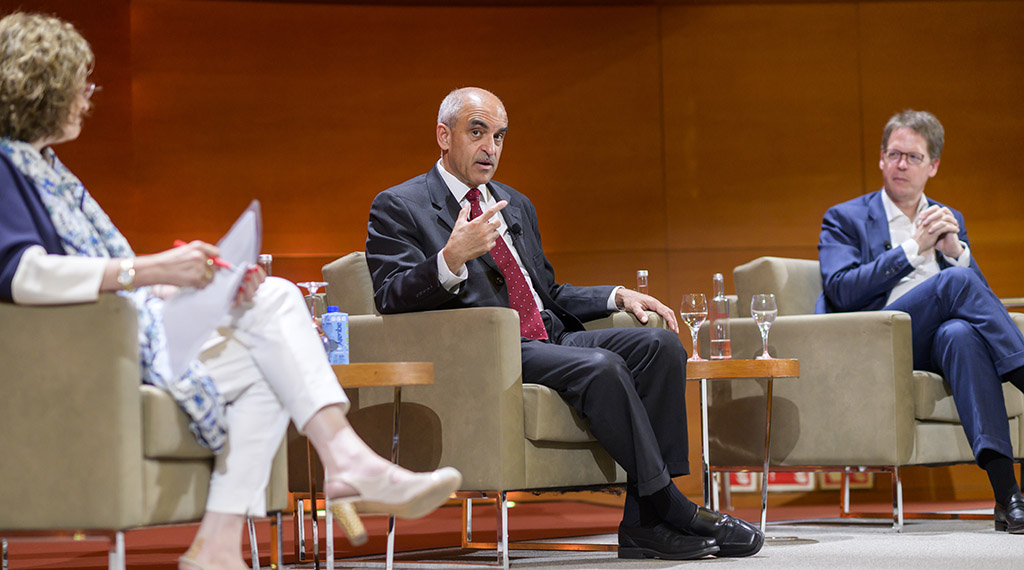Stories
Micky Lawler : “Leaders need passion and empathy”
The President of the Women’s Tennis Association (WTA) believes the future value proposition lies in togetherness
“A startup mentality is absolutely key to continued success for any business,” says Micky Lawler, President of the Women’s Tennis Association (WTA).
PHOTO: MARTA JORDI
March 5, 2020

Micky Lawler got into tennis by chance, but given her international background it seems only logical that she ended up working among a set of top professionals who can spend 11 months out of the year crisscrossing the globe to compete at the highest levels.
Originally from the Netherlands, her father’s job as a Philips executive took her family to live in many different countries. “Moving from country to country gave us a very wide perspective,” she says. After earning a master’s degree in applied linguistics from the University of Delaware, she moved to Paris, where she responded to a job advert for a multilingual press attaché for the Men’s International Professional Tennis Council – her entrance into the world of tennis.
Lawler went on to work for the sports marketing agency, Octagon, and during her 27 years there she joined the board of the Women’s Tennis Association (WTA), eventually becoming its President in 2015.
Tennis is one of the few sports where women command as much fame and fortune as the men and where, in the grand slams and combined events, the prize money is equal. When the WTA started in 1973, women earned a tenth of the prize money of men; over the past decade, the total prize money in women’s professional tennis has more than doubled, reaching record levels today.
“The growth has been incredible,” says Lawler. Here, she highlights what other professions can learn from tennis, where men and women both perform at the top of their game on the world stage.
What are the characteristics of top performers?
They’re very focused, disciplined and driven. One of the best athletes I ever met was also very well-rounded. She loved people and relationships, which is kind of the opposite of the robotic focus on “I need to win, win, win.” I remember talking to her at length about walking that fine line between humility and confidence, of having the utmost respect for your opponent while also having absolute confidence in yourself, of keeping a 30,000-foot view of a situation that’s bigger than yourself. Maintaining that balance, I believe, made her the champion she was.
The other thing I’d say is: you always need to have a Plan B. People get injured. The odds are stacked against you from the get-go. You can have incredible physical skills, but your mental skills have to be equally fine-tuned and strong. It takes hard work but also a lot of luck. You have to be passionate but also empathetic. There are many pieces and every piece needs to come together perfectly for it all to work.
Why is empathy so important for success?
Because only if you’re able to be non-judgmental and put yourself in someone else’s shoes can you fully understand the value proposition – where the wants and needs are, what the challenges are, where the opportunities lie. As the psychologist Tal Ben-Shahar said, in life you have the givers and the takers. The takers have no empathy. To be a good leader, you have to be a giver, not only to others, but also to yourself in terms of regulating your emotions, applying discipline and not losing control.
Your background helped you develop these qualities. For someone who hasn’t had such formative experiences, how can they develop these competencies?
I’d say that if your existence goes around a radius of X, then that radius needs to expand by Y. Whenever you’re thrust into a new situation, you’re going to have to look at areas that you’ve never looked at before, and you will learn them. It’s also worth remembering that you don’t have to be Superman or Superwoman in all areas. A leader should be okay with not being perfect in everything. You work to your strengths and surround yourself with a very solid team who complement each other, and you maximize the strength of the team. That’s how you learn and grow and lift your performance.
In what ways are you using technology to innovate?
For us, the biggest innovations have been on the content side and growing the digital footprint. The emergence of broadband has delivered a big opportunity for all of us in sports because we have no limit to the number of stories that we can tell, and it offers us the opportunity to have a direct relationship with our consumers.
With SAP, the WTA built a digital platform known as SAP Tennis Analytics, which analyzes data collected from the chair umpire’s scoring and combines it with Hawk-Eye technology. This has completely revolutionized the sport, from how the media report to fans, to how coaches train their players. This technology continues to evolve, as the WTA recently unveiled a new tool called Patterns of Play, allowing coaches to investigate how a rally unfolds point by point. Data is increasingly changing how we approach all aspects of our sport. With SAP, we’re able to stay on the cutting edge of where technology will take women’s tennis in the future, from fan engagement and gaming, to new revenue streams and the next level of competition on the court.
Another area is over-the-top (OTT) streaming services, which afford other huge opportunities beyond the traditional networks paying for your television rights. In China, for example, we launched with an OTT platform called iQiyi, which is sort of like Netflix, YouTube and Amazon rolled into one, where they distribute but also develop native content.
Sport, as in business, has to live in lockstep with shifting global influences
Regarding China, why choose Shenzhen for the WTA Finals for the next 10 years?
Sport, as in business, has to live in lockstep with shifting global influences. That requires optimizing existing revenue streams while also discovering new ones and serving the growing demand coming from markets that used to be considered secondary but are now becoming prime. What’s astounding about sport is that one star athlete, like Li Na in tennis or Yao Ming in basketball, can drive an entire nation to shape the direction of those global shifts. The 2008 Olympic Games in Beijing also really made the opportunities apparent. We now have 11 events in China. The market evolution over the past 20 years in China has been remarkable.
At the same time as mirroring these global shifts of influence, we have to remain quite flexible, constantly open to new opportunities, new markets – and new challenges. We are especially sensitive to the difficult times that our Chinese athletes, colleagues and partners are experiencing with the coronavirus outbreak. Our thoughts are with everyone in China as we monitor the situation closely. This part of the world is near and dear to the WTA family and we continue to support and protect the health and livelihood of our players, staff and fans while this situation is managed closely on all fronts. The WTA has a long history of positive growth in China, and we consider it a valuable investment in the WTA Tour to increase diversity across the sport’s international field of talent.
There have been big debates about male and female athletes being treated differently, particularly in terms of pay. What’s your take on this?
This is a complex topic, but what’s very simple is: while there are differences between the men’s and women’s business models, the argument should not be based around gender or talent; the argument should be based within the field of player profiles and those fueling the business. In examining the combined events, we’ve seen a long history of tennis stars on both sides take turns driving the sport. Unquestionably, there’s no place for ever considering anything but equal pay, whether in sport or in business. A female engineer needs to earn the same as her male counterpart. Period.
Two female astronauts recently made an interesting point about the first all-female spacewalk. On the one hand, they said, it shouldn’t matter if a man or a woman is on their team; in the end, you just want to work with people who have the right skill set. On the other hand, the astronauts recognized the need for milestones and for young girls to have role models. It’s like that with the WTA. Again, it’s about skill level, performance level, quality and, yes, the business models between the men’s Association of Tennis Professionals (ATP) and the WTA are a bit different. But gender equality, in this day and age, is absolutely key to human evolution. And we realize these debates are about something much bigger: we’re contributing, even in the tiniest of ways, to social change. So, we carry the torch, even though I find it sad that we’re still talking about it, like when businesses say, “We have 40% women represented, isn’t that fantastic?” I live for the day when we don’t have to say that anymore, because we’ll all be together. But we’re not there yet.
Do you think the WTA and ATP will ever come together?
For the WTA and the ATP to be one association, one tour, one organization – that would be my dream come true. The game of mixed doubles, when men and women play together, is great, and the athletes enjoy it a lot themselves. I believe that’s where the future value proposition lies. Togetherness.
A version of this interview is published in IESE Business School Insight #155.
Micky Lawler spoke on “Driving Innovation” at IESE’s Global Alumni Reunion 2019 in Barcelona:



